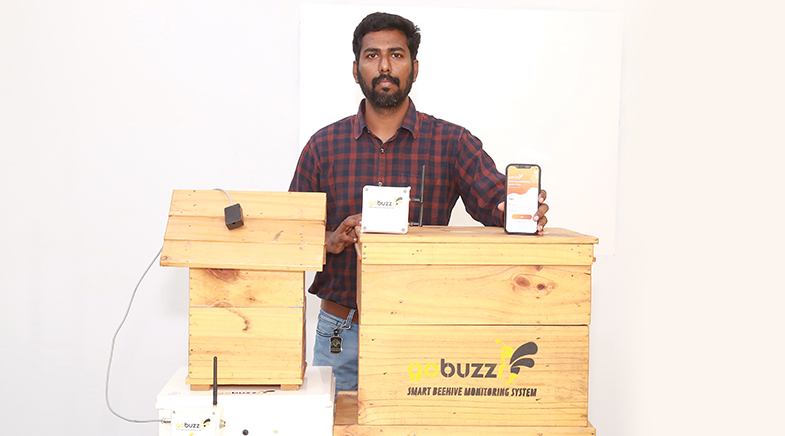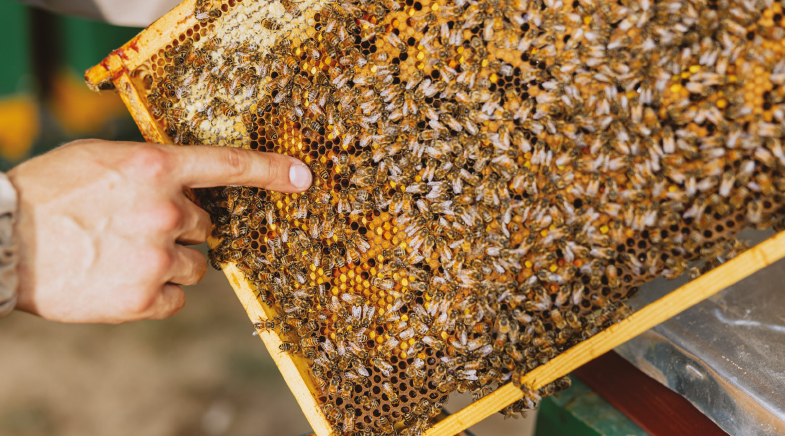The bee-tech biz is abuzz
-
- from Shaastra :: vol 01 issue 06 :: Nov - Dec 2022

A swarm of young beekeepers are developing affordable technology to maximise hive production, modernise a traditional livelihood, and advance conservation.
When Dipen Patel, 38, was exploring ways to prevent the theft of highly priced sandalwood from his family's plantation in Gujarat, he conceived of a fiendishly clever high-tech plan. Patel, who teaches in an engineering college, set up bee boxes with IoT (Internet of Things) vibrators beneath them. The idea was to switch on the vibrators remotely when an intrusion was noticed; the agitated bees would swarm out of the hives and attack the intruders!
The idea did not work as planned because bees abandon their hives in the non-flowering season. Patel, however, was by then well and truly bitten by the beekeeping business. He started Bee Farms Products in 2018, with 250 bee boxes, breeding the European bee species Apis mellifera. When the hives are placed in monoculture locations, the bees produce single-flora honey, which has high market value. Patel sells 36 varieties of honey, including litchi, jamun and a somewhat unusual flavour: ajwain.
India ranks eighth globally in honey production, and ninth in honey exports. However, honey collection in the country is mostly in the unorganised sector. Most commonly, it serves as a source of livelihood or additional income for tribal communities, which gather honey in forests in the traditional way.
GoBuzzr provides real-time information on the hive temperature, humidity and weight, and also puts out alerts if there are sudden changes in the hive.
In other countries, apiarists use a slew of technology, including Artificial Intelligence, robotics, and satellite communication. Using special sensors, these tools can monitor the health of a hive, track the presence of the queen bee, and even estimate the weight of the hive in real time. There are, additionally, robotic flowers, in which the pollen is pumped into the synthetic part of the flower that contains the pollen; these draw bees, and keep them within a specific range or, alternatively, attract bees to a specific area.
Indian apiarists, however, still follow rudimentary methods of hand-rearing bees and using hand-operated centrifuges to extract honey. Hi-tech inputs are low, because beekeeping is practised largely by subsistence farmers, who have little capital to invest in technology. In recent times, the government marketing arm for village enterprise products, and some non-governmental organisations have been encouraging beekeepers to also sell beeswax, bee pollen and the resinous propolis, which are in demand in the cosmetics and wellness industries. In 2020, the Indian government launched the National Beekeeping and Honey Mission, and many young entrepreneurs are giving this buzzing business a shot.
In such a socio-economic milieu, the challenge for innovator-entrepreneurs like Patel is to develop technology that is robust and also affordable.
HIGH-VALUE PRODUCTS
Patel focused on a less-used side produce, the bee venom. Found in the bee sting, this is a colourless acidic liquid used to treat bee sting allergy. It is also used in symptom-relieving treatments for arthritis, multiple sclerosis, cancer and HIV. Harvesting bee venom is difficult. When a bee stings an enemy, it is physiologically incapable of extracting the stinger from the target's flesh after injecting the venom. As a consequence, bees can die when they sting. Apiarists, therefore, encourage the bees to strike a glass sheet and inject their venom – without themselves perishing in the act. The venom crystallises immediately and can be collected later.
Venom collection kits are imported and exorbitantly priced: the landing cost is ₹1.25 lakh. Patel's team designed an indigenous one, priced at ₹40,000. Buyers get an orientation course on using it. His company also buys the venom from farmers to sell to pharmaceuticals; the collectivisation effort works better because farmers find it difficult to sell individually.
Patel is tinkering with many other innovations. One is a low-cost version of the flow hive, designed to allow honey to flow into a container beneath the hive, without disturbing the bees. He is also developing a plastic frame which, he says, will help extract more honey from the hives. He has additionally developed bee venom capsules for symptomatic relief of arthritic and other pains. The product is being tested. Patel's business, with a turnover of ₹50 lakh, has more than doubled the investment.
MONITORING THE BEES
Kapil Dev (38) was in Africa, in connection with his software business, when he gained some insights into beekeeping as it was practised there. As in India, it was characterised by low tech and was labour-intensive. To check on a hive's condition, for instance, the bees needed to be smoked out of the hives.
Dev, an electrical engineer, realised that IoT technology could help monitor the beehive, and came up with the idea for a smart beehive monitor, GoBuzzr, in 2019. When placed beneath the bee box, GoBuzzr provides real-time information on hive parameters such as temperature, humidity and weight, through a mobile app, and also puts out alerts on sudden changes in the hive. For now, the monitor is electric-powered, but Dev is developing a battery-operated model suited for rural conditions. He has invested ₹30 lakh, including a World Bank loan. The prototypes are still being tested.

Bees communicate through sound, and the research team is looking to add an acoustic sensor that can send out alerts about the death or the absence of a queen bee or any other major issue in the hive. If the queen is gone, the other bees will abandon the hive, too. With timely warning, the apiarist can introduce another queen to the hive, and retain the workers.
GoBuzzr comes at a fifth of the cost of beehive monitoring systems in the West. To lower the cost, he created the master-child device system, in which the 'child' is placed under each bee box, and passes the information to the master device, which has a SIM card and is tethered to an app. One master can communicate with about 10 hives. Each such device will be priced at ₹50,000.
Dev is also developing a platform where information from monitoring systems such as GoBuzzr is collated so that governments can keep track of honey production across the country.
POLLINATION SERVICES
Not every apiarist is embracing technology to upscale business. Some are focusing on getting farmers to optimise basic natural sciences. For instance, Apoorva B.V., an engineering graduate, has taken up apiculture – with a twist. He has drummed up a business in selling hives – not to produce honey primarily, but as farm pollinators. In southern India, there are fewer crop cycles, and so honey production is less than in the North. Apoorva trains farmers, therefore, to deploy bees to pollinate farms: physically inspecting hives every 10 days to check for the presence of the queen bee, and for infections. During the off-season, when there aren't enough flowers, the bees need to be fed sugar to keep honey production consistent.
Crop yields increase by up to 80% when bee boxes are placed in farms. Bee pollination also improves the quality of fruit and seed production.
Studies have established that crop yields increase by up to 80% when bee boxes are placed in farms. Bee pollination is also known to improve the quality of fruit and seed production. One farmer in Belgaum (whom Apoorva trained) claims to have doubled sunflower seed production with the use of bee boxes.
While North India is conducive to good honey production, there is a general decline in bee populations because of pesticides. Shubham Rana based his business model on this shortcoming. Rana, an agricultural sciences graduate, tied up with the Horticulture Department of Uttarakhand, which pays him to keep bee boxes in the apple farms of Uttarkashi during the flowering season, to aid in pollination. His team stays on the site for the period, monitoring pollination, and also earning from the honey produced.
In other words, whether it is designing indigenous devices to extract the most produce from hives – be it honey or wax or resin – or whether it is strategically using apiculture to increase farm yields, a new generation of apiarists are buzzing with ideas.
Have a
story idea?
Tell us.
Do you have a recent research paper or an idea for a science/technology-themed article that you'd like to tell us about?
GET IN TOUCH














